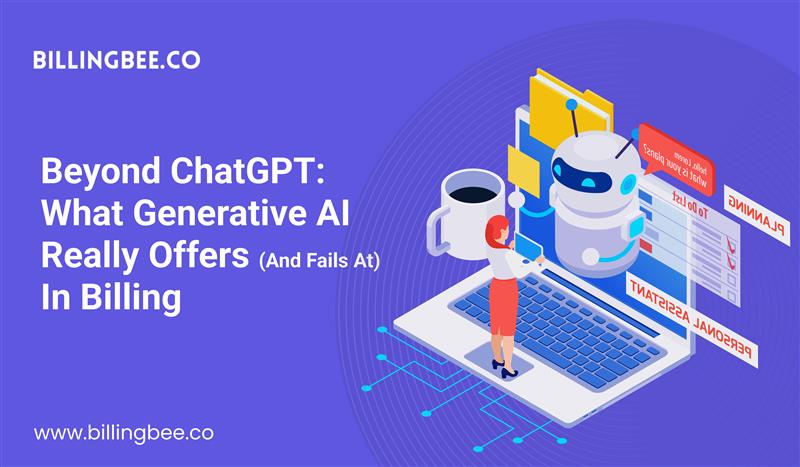Beyond ChatGPT: What Generative AI Really Offers (and Fails at) in Billing




Beyond ChatGPT: What Generative AI Really Offers (and Fails at) in Billing
When most people hear generative AI, they immediately think of ChatGPT writing emails, blogs, or even coding. But in the financial world—especially in billing—the story is more complex. AI is not just about writing; it’s about making sense of data, reducing errors, and rethinking how businesses interact with money.
But here’s the honest truth: while generative AI brings groundbreaking opportunities, it also comes with frustrating limitations. To understand where it truly shines—and where it still stumbles—we need to go deeper.
The Real Promise of Generative AI in Billing
Imagine this: you’re a finance manager juggling hundreds of invoices every month. Some are late, some have errors, and some need manual follow-up. Now picture an AI that quietly works in the background, generating invoices, flagging suspicious entries, and even reminding clients about payments—in their own preferred tone. That’s where generative AI starts to feel less like hype and more like a helping hand.
Here’s what it does well:
- Fewer Errors, Faster Invoices
Manual billing errors are still one of the biggest pain points for businesses. Generative AI can scan multiple data points—client names, project codes, tax details—and auto-generate clean, professional invoices within seconds. No typos, no mismatched amounts, no forgotten line items.
- Human-Like Client Communication
Instead of robotic payment reminders, AI can adjust the tone of messages. It might send a polite, friendly note to a loyal client, but a firmer reminder to a customer with a history of late payments. This subtle personalization can improve client relationships without adding work to your team. - Fraud and Anomaly Detection
Billing isn’t just about sending invoices; it’s about protecting revenue. Generative AI can sift through millions of past transactions, spotting unusual patterns that humans might miss. For instance, duplicate invoices, mismatched bank details, or amounts that don’t align with contract terms. - Global Adaptability
Businesses working across borders often struggle with varying tax rules and compliance needs. AI can automatically format invoices to match international requirements, saving hours of manual effort.
Where Generative AI Still Misses the Mark
But let’s be clear: AI is not magic. There are still serious gaps when it comes to billing.
- It Doesn’t Understand Context
Let’s say a client disputes a charge because your service was down for a day. AI can pull numbers, but it can’t grasp the human reasoning behind such exceptions. You still need a person to resolve sensitive financial conversations. - Struggles with Constantly Changing Regulations
Compliance frameworks change overnight, especially in industries like healthcare or international trade. Generative AI can help track these—but it still needs manual updates and oversight to stay relevant. - Privacy and Data Security Risks
Billing data is highly sensitive. Feeding it into AI systems raises concerns about data misuse, GDPR compliance, and client trust. Without strong encryption and ethical policies, this can quickly turn into a liability. - Hallucinations in Financial Reporting
Just like ChatGPT sometimes invents facts, billing AI can generate false financial insights if the data is incomplete or poorly structured. That’s a big risk in a world where accuracy is non-negotiable.
Why Humans Still Matter in AI-Driven Billing
One of the biggest misconceptions is that AI will “replace” finance professionals. The truth is the opposite: AI is best when paired with human oversight.
Think of it like this—AI is the assistant that never sleeps. It can handle repetitive tasks, crunch numbers, and send reminders at scale. But humans bring judgment, empathy, and ethical decision-making that no algorithm can match.
For example:
- AI can flag a suspicious invoice, but a human decides if it’s fraud or just an unusual transaction.
- AI can send automated reminders, but a human knows when to pick up the phone and call a client directly.
This human-AI partnership is what makes billing both efficient and trustworthy.
Looking Ahead: The Future of Generative AI in Billing
So, where is this all heading? The evolution of generative AI in billing is still in its early chapters. We can expect to see:
- Predictive Cash Flow Insights: AI telling you when your next payment bottleneck might happen.
- Voice-Activated Queries: Asking, “Hey AI, how many invoices are overdue this week?” and getting an instant answer.
- Adaptive Compliance Engines: Systems that update themselves automatically as new laws roll out.
- Deeper Integration with Accounting Tools: Creating a seamless ecosystem where billing, payroll, and reporting work in sync.
But no matter how advanced these systems become, one thing will stay constant: businesses will always need human oversight to keep AI’s output ethical, accurate, and grounded in reality.
Generative AI in billing is more than just hype—it’s a transformative shift in how financial workflows operate. It can automate, personalize, and predict, but it still stumbles when nuance, ethics, and human understanding are required.
The future isn’t about replacing finance teams with machines. It’s about giving humans the tools to work smarter, not harder. If there’s one lesson to take away, it’s this: AI can be the engine, but people remain the drivers.